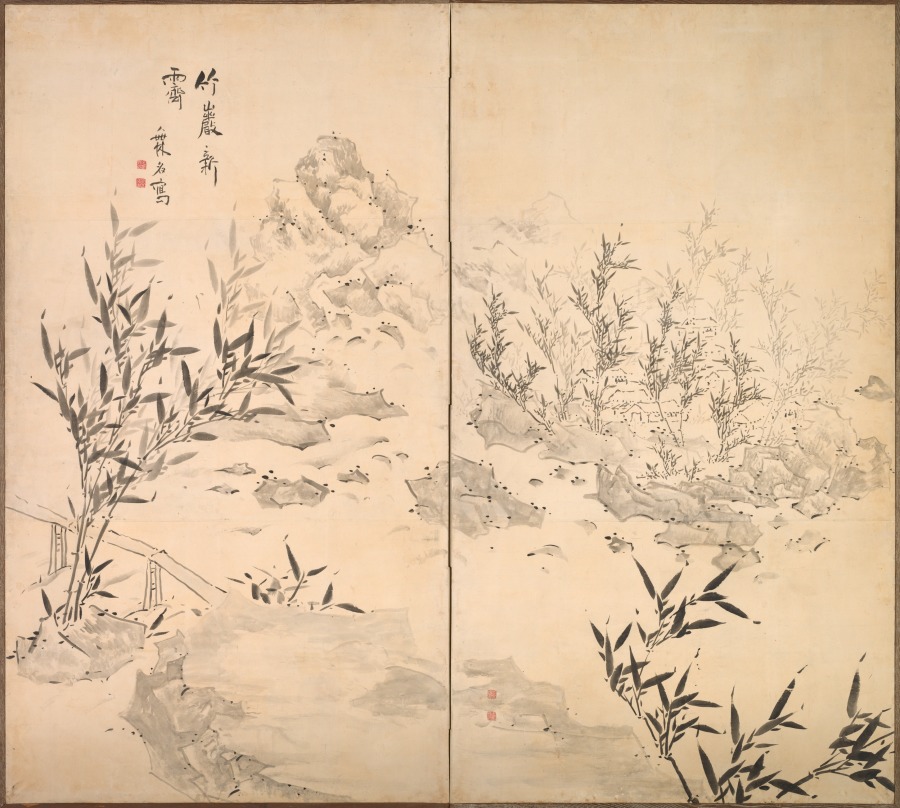

| rdf:type | <https://jpsearch.go.jp/term/type/絵画> |
| rdfs:label | "Bamboo in Fine Weather after Rain" |
| schema:name | "Bamboo in Fine Weather after Rain" @en |
| ns0:accessInfo | #accessinfo |
| ns0:agential | _:vb4329876 (an orphan bnode) |
| ns0:relatedLink 4 | _:vb4329878 (an orphan bnode) |
| ns0:relatedLink | _:vb4329879 (an orphan bnode) |
| ns0:relatedLink | _:vb4329877 (an orphan bnode) |
| ns0:relatedLink | _:vb4329880 (an orphan bnode) |
| ns0:sourceInfo | #sourceinfo |
| ns0:temporal | _:vb4329881 (an orphan bnode) |
| schema:creator | <https://jpsearch.go.jp/entity/chname/池大雅> |
| schema:dateCreated | "1700-1799" |
| schema:description 10 | "collection: ASIAN - Folding screen" |
| schema:description | "type: Painting" |
| schema:description | "tombstone: Bamboo in Fine Weather after Rain, mid-1700s. Ike Taiga (Japanese, 1723-1776). Two-fold screen; ink on paper; image: 163.2 x 182.6 cm (64 1/4 x 71 7/8 in.). The Cleveland Museum of Art, Purchase from the J. H. Wade Fund 1958.337...(more)" |
| schema:description | "wall_description: As this two-fold byøbu demonstrates, Taiga ranks among the most creative painters of the Edo period. By sheer industry and with unfettered talent, in three and one-half decades he produced an oeuvre exceeding one thousand compositions, in various formats. While he was unencumbered by a traditional education in the classical literature and philosophy of Chinese civilization, he nevertheless gravitated toward standard themes. He was familiar with native painting themes and techniques, but his circle--fellow artists, writers, and intellectuals--all favored the cultural realm of the artist-scholar grounded in Chinese studies. Skilled with brush and ink, and a consummate professional, Taiga had begun supporting himself and his widowed mother while he was still a teenager. Their livelihood depended on the sale of his pictures and calligraphy executed in a variety of stylistic modes. But since most of his customers during his mature years considered themselves learned and sophisticated in their aesthetic choices, Taiga's production conformed basically to the eighteenth-century taste in Kyoto for so-called literati-style paintings and subjects. This byøbu suggests the powerful aspects of Taiga's art: visual disjunctions, wildly disproportionate assemblages of natural and man-made forms close to one another, and a surprising tonal "coolness." Indeed, the natural prospect here is fundamentally at odds with so-called Western reality, but it has a peculiar kinship with a contemporary Western aesthetic that savors discon-nected imagery and formal tensions. Taiga's view of landscape here is highly eccentric, featuring summary land masses that look so fragmented they seem to be in a state following collapse. Yet nestled to the side of the mountain peak in a grove of gigantic bamboo appears a cluster of thatched huts painted in light dabbles of ink, almost in a kind of pointillist manner. The bamboo and surrounding boulders are sturdy, formidable presences concocted out of an extraordinary subtle hue of ink. This passage must be one of the most haunting visions in all of eighteenth-century painting, especially as it remains so intrinsically unassuming. The foreground plateau framed by enormous dark bamboo stalks provides the principal declarative state-ment, engaging and no doubt confounding viewers with their placement and scale. A three-planked footbridge proceeding across a stream and out of view looks like a child's toy next to the bamboo, but it does not strike a discordant note. In fact, while bowing to recognizable historical precedents in literati painting, this fabulous, lighthearted concoction goes about re-inventing the idea of landscape painting element by element, as if parsing the origins of visual language....(more)" |
| schema:description | "measurements: Image: 163.2 x 182.6 cm (64 1/4 x 71 7/8 in.)" |
| schema:description | "creditline: Purchase from the J. H. Wade Fund" |
| schema:description | "id: 135333" |
| schema:description | "inscription: signed, titled, and sealed by the artist on the top of the left panel. Set of two seals appears once on each panel: after the signature on the left panel and lower left on the right panel. The first of the two square seals reads "ike no mumei," the second reads "sangaku doja."...(more)" |
| schema:description | "technique: two-fold screen; ink on paper" |
| schema:description | "culture: Japan, Edo period (1615-1868)" |
| schema:image | <https://openaccess-cdn.clevelandart.org/1958.337/1958.337_web.jpg> |
| schema:relatedLink 4 | <urn:x-cite:Handbook_of_the_Cleveland_Museum_of_Art_1969._Cl-g2858235092> (➜ "Handbook of the Cleveland Museum of Art/1969") |
| schema:relatedLink | <urn:x-cite:Cleveland_Museum_of_Art,_and_Michael_R._Cunningh-g558746523> (➜ "Unfolding Beauty: Japanese Screens from the Cleveland Museum of Art") |
| schema:relatedLink | <urn:x-cite:Handbook_of_the_Cleveland_Museum_of_Art_1978._Cl-g1739799197> (➜ "Handbook of the Cleveland Museum of Art/1978") |
| schema:relatedLink | <urn:x-cite:Handbook_of_the_Cleveland_Museum_of_Art_1966._Cl-g3331029666> (➜ "Handbook of the Cleveland Museum of Art/1966") |
| schema:temporal | <https://jpsearch.go.jp/entity/time/1700-1799> (➜ "1700~1799年") |
This resource "Bamboo in Fine Weather after Rain" is, in addition, simply-referenced by the following URIs. (The next table describes reverse link where the right and left columns represent the subject and the predicate respectively and whose object is this resource, in the source. These subjects have no other attribute in this source.)
| is schema:workFeatured of 5 | <http://purl.org/net/ld/jpsearch/data/cleveland-exhib-asian-autumn-1993> |
| is schema:workFeatured of | <http://purl.org/net/ld/jpsearch/data/cleveland-exhib-byobu-1987> |
| is schema:workFeatured of | <http://purl.org/net/ld/jpsearch/data/cleveland-exhib-japanese-screens-1977> |
| is schema:workFeatured of | <http://purl.org/net/ld/jpsearch/data/cleveland-exhib-screen-2001> |
| is schema:workFeatured of | <http://purl.org/net/ld/jpsearch/data/cleveland-exhib-suibokuga-1985> |